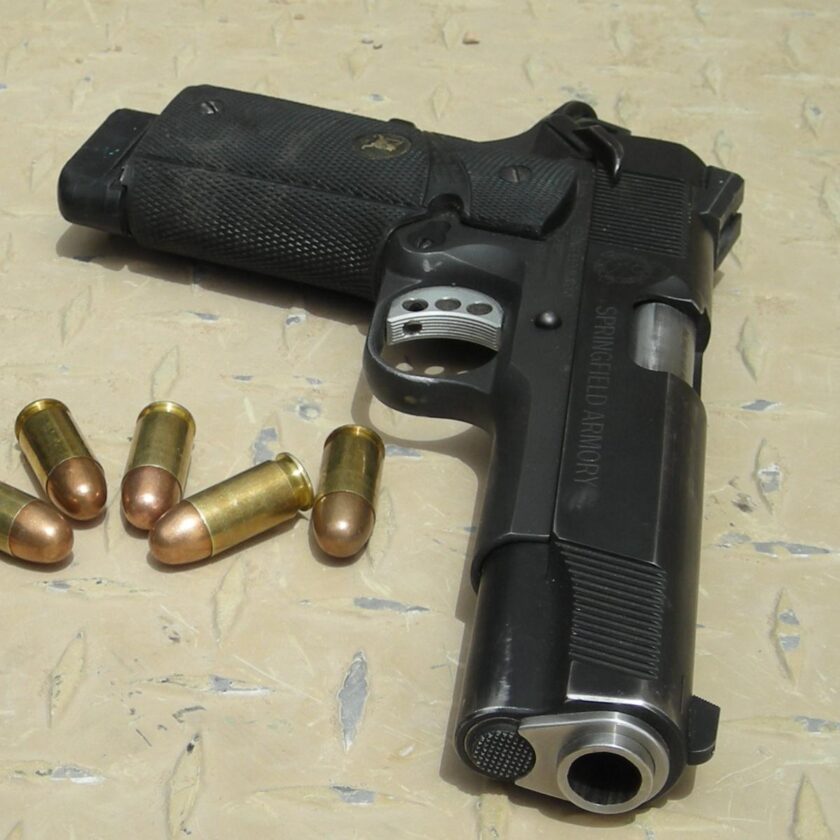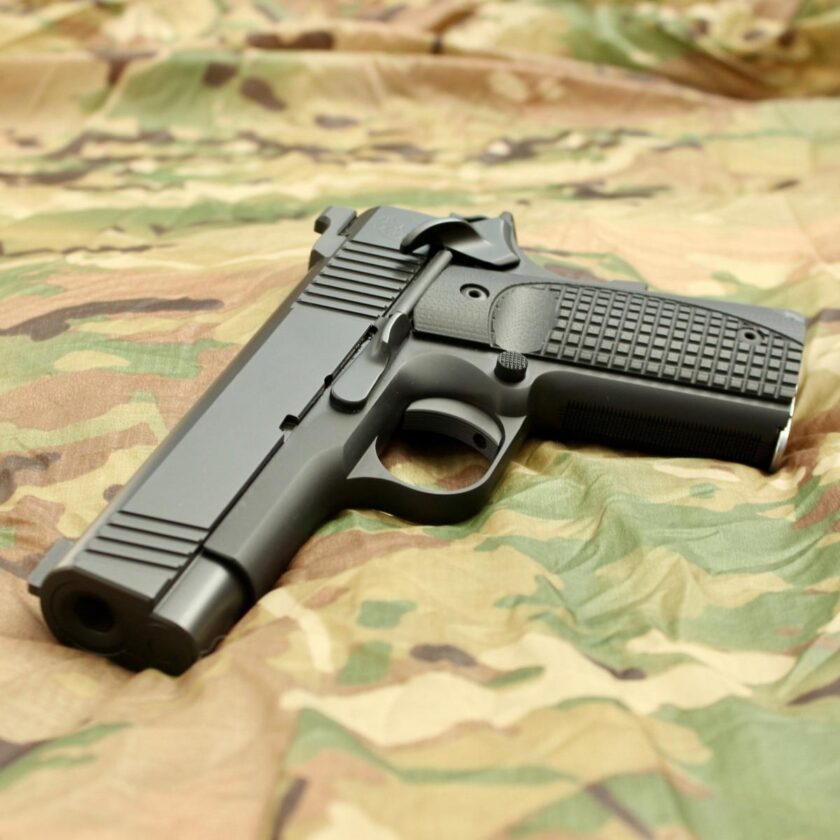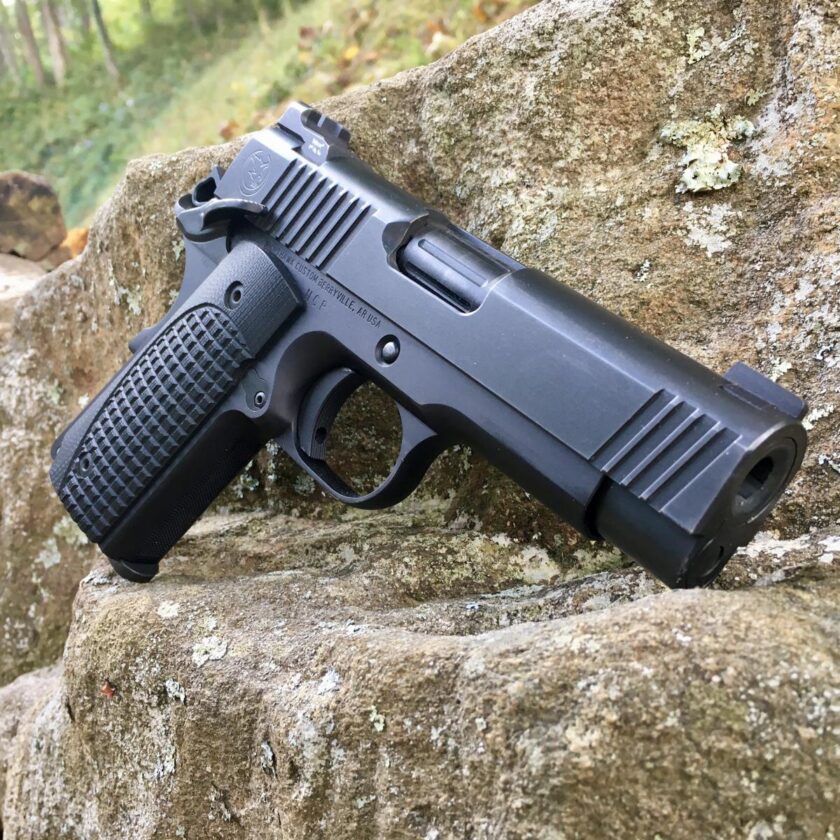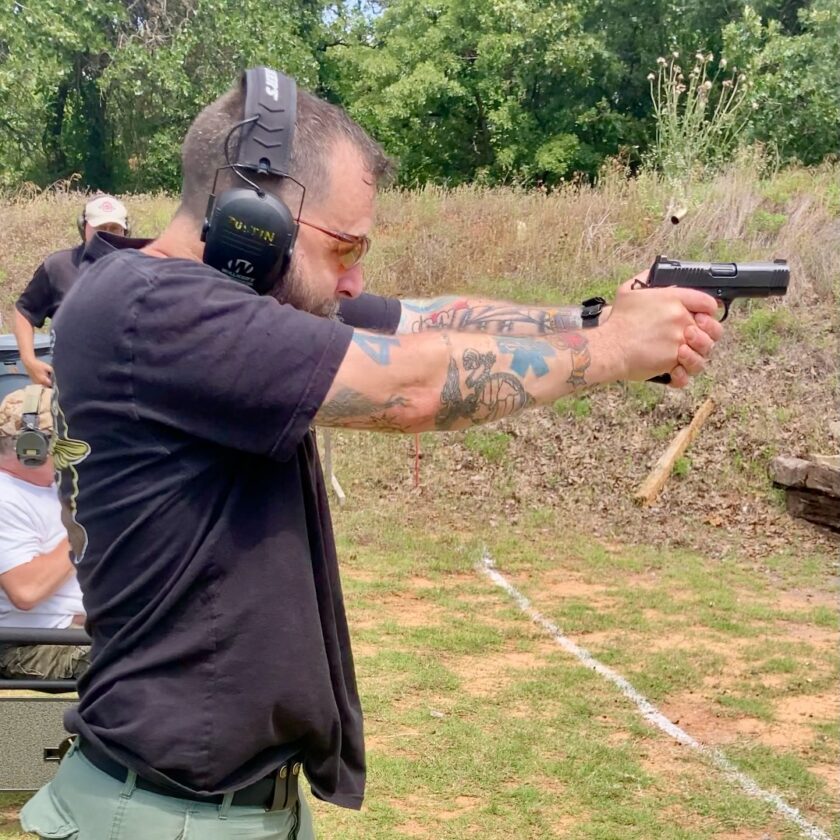This idea occurred to me when a good friend recently said, “you know, if I could only have one handgun it would probably be ___†.” I immediately thought, I already own mine – the one gun I would have if I could only have one gun. It is the one with the most utility, the one with which I have the most familiarity and skill, and the last one I would ever part with. If I could only have one, it would certainly be my EDC handgun.
Disclaimer: This article contains affiliate links to Amazon.com. I have no other financial relationship with any other company, manufacturer, or entity mentioned in this article.
†That friend is Jason. He’s a career cop, but don’t let that fool you. We met at the Cognitive Conclave. He’s a very well-trained dude and has some deep thoughts on handguns. I am trying to convince him to write an article about his “only one” gun.
The “If I Could Only Have x Gun(s)” Series
Welcome to the “If I could only have _ gun(s)” series! I know this type of article has been done to death, but I really enjoy discussing it! It’s a fun problem to solve: getting yourself down to the bare minimum hardware, while still covering all the bases.
My series will proceed up to at least five guns. Each article will cover only one gun, and build on the articles behind it. It may go beyond five, but currently the plan is to cover my “core 5” firearms that I don’t want to try and live without. All of these articles will follow basically the same format, first explaining the “why” behind that general category then explaining my particular choice to fill that category. Due to the complex explanations behind these choices, these will be lengthy articles.
If I Could Only Have One Gun: EDC Handgun
If I could only have one gun, it would be the EDC handgun. Why a handgun and not a rifle? This is reasonable question, considering that carry handguns typically make some fairly big compromises in regards to size and capacity. Added is the fact that when you need a long-gun, little else will do. Versus a long gun, a handgun is seriously handicapped.
Simply put, though, the EDC handgun is the gun that can do the most good. It is the firearm that you can have about your person 99% of the time. The EDC handgun is the gun that most of us can live with, most of the time. It also addresses the threats that most of us are most likely to face. Let’s be honest: the reality is that you will almost never need a long gun to solve a defensive problem. And only the tiniest few of us are going to participate in active combat, or need to stop a charging grizzly. Most of us do, however, need a small, lightweight, concealable handgun that can almost always be carried discretely (yes, that “almost” is foreshadowing). It can be used to stop the attacks we are most likely to face: the close-range, opportunistic criminal attack.

But it’s not necessarily pigeon-holed into that role. The capability of an EDC handgun is somewhat limited by the handgun itself. It is far more limited by the user. I have seen guys do amazing things with J-Frame revolvers. They wouldn’t be my first choice for much of anything, but handled well they can make hits out to 100 yards. This is why my EDC handgun is the gun I shoot in most classes, and the gun I take to the range most often. It is also the pistol with which I have two full years of documented, daily dry practice (Year 1, Year 2).
Which One I Could Have
Now we get to the actual gun I would choose, if I could only have one. I already own it: it is my Nighthawk Custom 9mm 1911 (first look, 5,000-round review). This particular gun is – at least for me – the perfect everyday carry gun. It is a bespoke, custom handgun that I ordered as a custom build in the spring of 2018. Delivered to my FFL almost exactly six months later, it is an Officer-sized, 1911 design. Let’s take a look at what makes this gun the perfect everyday carry gun for me… and why it is the one gun I’d have if I could only have one gun.
Why a 1911?
The first and most logical question to ask about this gun is why the 1911? The most important reason is that I experienced the “law of primacy,” a concept well known amongst aviators.

Per the FAA Aviation Instructor’s Handbook, “Primacy in teaching and learning, what is learned first, often creates a strong, almost unshakable impression…” Coupled with another law of learning, the “law of intensity” (“Immediate, exciting, or dramatic learning connected to a real situation teaches a learner more than a routine or boring experience”), it is very difficult for me to want to migrate away from the 1911 platform.
Firepower counts. Ballistic potency counts. Ergonomics and “shootability” may count even more. ~Massad Ayoob
I experienced primacy and intensity of learning with the 1911 in a Force Reconnaissance “shooting package.” It was the first pistol I learned to shoot under expert instruction. I put tens of thousands of rounds through it. The training was a pressure-cooker intense, where passing meant moving on in training and deploying, and failing meant you were shit-canned from your platoon. This dug a deep groove in my shooting psyche. I wish I had experienced this with a Glock 17 or 19, but unfortunately I’ve never been as comfortable with anything as I am with a 1911.

But that’s not all. Despite the reputation of the “fearsome Colt .45,” the 1911 is a very thin firearm. It is very comfortable in the waistband. Importantly for me, it also fits my hands (which run small) very well. The small grip size makes the 1911 a very comfortable and controllable pistol for me.

It feels important to point out that I’m not trying to talk you into a 1911. It’s probably not a good choice for you…but it is for me. I also don’t sweep its shortcomings under the rug, or choose it because “two world wars!” or “it was good enough for papaw!” or any other nostalgic nonsense. It is just the gun that I can be fastest and most accurate with. So indeed, let’s address the shortcomings.
Strikes Against the 1911
There are a few reasons why a 1911 might not be the ideal single gun, if I could only have one gun. I will get to capacity, but the first is the difficulty in repairing or replacing this pistol. Even in the best of times, it is hard to find a gunsmith I would trust to work on my 1911. I certainly don’t trust myself. I keep spare springs and a spare extractor around, but if a catastrophic breakdown occurs, I’m essentially stuck. Having an identical duplicate is a very costly proposition. A Sig P355XL or Glock 48 would be a better choice for most, for these reasons.
Next is capacity. This is an 8+1 pistol with a flush-fit mag, or a 10+1 with an extended mag. In a nearly identical footprint, the 10+1 Glock 48, I can easily carry 20% more ammo. In a Sig P365XL I can easily carry 12, 15, or 17+1 without getting significantly larger than my 1911. I don’t expect to need more than 8+1, but more ammo is absolutely, objectively better. Sub-10-round capacity does, however, come with an unexpected benefit: this gun is 50-state legal…or at least as legal as handguns get in gun-unfriendly states. I certainly don’t rule out travel to or through some of those places, so it’s nice not to have a pistol that is as broadly legal as they come.
Why *This* 1911
I’ll be honest with you, I wouldn’t carry just any old 1911. This gun was built for me, to my specification. It was everything I wanted in a pistol, and nothing I didn’t. Since I have owned it, I have made a few very alterations, which we’ll get into. First, let’s explore this pistol.

This particular 1911 is chambered in 9mm and built on an Officer-sized, aluminum frame. The barrel is 3.8-inches long; shorter than a Commander, but longer than a true Officer. It has a balanced look and a very usable barrel length, and the grip holds a flush-fit, 8-round magazine. The grip screw bushings are for slim grips, making the grip extremely comfortable to my small/medium hands.

Custom touches include a cone barrel with a full-length, Everlast recoil system. The ambidextrous safety was very important to me, and this pistol also has a slightly extended slide latch. The front strap and main spring housing are sharply checkered, the slide has coarse front and rear cocking serrations, and sights are Heinie Straight-8s with a ledge. Finally, the barrel, trigger, and plug are blacked out, a purely aesthetic decision, but one that I remain really happy with. This 1911 is compact and lightweight, but offers the reliability, accuracy, and recoil management of a much larger pistol.

Modifications: Round 1
Approaching seven years of daily carry, there is very little about this pistol I wish to change…though I have made a few changes. When I ordered this 1911, I thought I had designed the perfect pistol. I had gotten very close, but over time I noticed a few things I wanted to modify. I didn’t rush into anything, however. All modifications occurred after ample use; I carried it 100% as-is, from the factory for over five years.
The first was the installation of a flat trigger. This pistol originally shipped with a short, curved trigger. There was absolutely nothing wrong with it. I like the look of a flat trigger, but I honestly don’t think it has changed much of anything in regards to how the gun shoots.

At the same time the flat trigger was installed, I had a new front sight installed. The finish had largely worn off the original sight making it grey, and blending with most targets. I replaced it with a Trijicon HD sight. The bright, orange ring is so easy to pick up. Two years later it is just as bright as it was to begin with.

Modifications: Round 2
Another, mostly cosmetic mod is the grip panels. I have swapped out grips a twice now. Once for some short-lived VZ grips, then for LOK Bogies, which imitate the old Simonich Gunner Grips. The reason I went with LOKs instead of the VZ Simonich Gunners is that the LOKs are available for thin grip screw bushings, keeping the pistol as compact as possible. These grips provide excellent purchase, and compliment the looks of the gun.
I came up on iron sights and I absolutely love irons. For years I was extremely proud of what I could do with a iron-sighted pistol. Despite my love of iron sights, I seem to have reached a point where I can’t quite get them to do what I want them to do.

Early this year I sent the gun in for Nighthawk’s Interchangeable Optic System. I firmly believe this is the best optic system available for the 1911 platform, and I will provide a full review of the IOS in a future article.

I very briefly installed a one-piece magwell/MSH. And I quickly learned that it altered the weight/length balance just a bit too much. It tipped the gun into “too big and too heavy” territory. The magwell also required the use of a 9-round magazine, the basepads of which were just a bit too big. It was quickly removed.

R.E.A.P. Methodology
That’s the gun itself, now let’s look at what it can do.
Reliability
The most important factor in the selection of any defensive firearm is reliability. Above all else, reliability – the gun must work! The 1911 has gained a reputation for unreliability (though this is somewhat overblown and undeserved, in my opinion). Regardless of what all other 1911s do, this 1911 is reliable. I have taken it to several firearms classes, including Dusty Soloman’s pilot Tactical Vision Course, the inaugural Cognitive Conclave, and Simon Golob’s On Demand Performance. It has made it through every class I’ve taken it to without a bobble.

More scientifically, I have tracked every single round I have fired through this gun. At the time of writing this gun has 15,332 rounds through it. This is mostly S&B 124-grain ball ammo, but also includes a bunch of defensive ammo including:
- Federal HST 124-grain JHP +P
- Federal 115-grain Hi-Shok JHP
- Hornady Critical Duty 124-grain +P
- Winchester Defender 124-grain JHP
- Remington Golden Saber 124-grain JHP
- Winchester Ranger T-series 147-grain JHP
- Speer Gold Dot 124-grain JHP
None of the defensive ammo has ever hiccuped. I have had a handful of malfunctions with this handgun over the years. Most occurred early on, using the supplied MetalForm magazines. Since switching to Wilson Combat ETM magazines, malfunctions have almost disappeared completely. This pistol has not had a malfunction of any kind in 4,752 rounds, almost a third of its total round-count.

My every day carry load in this pistol is currently the Winchester 147-grain Ranger T-Series (RA9T). My personal preference is Federal HST but the Ranger-T is my agency’s duty load.
Ergonomics
Ergonomics is where the 1911 really shines for me. This gun is like coming home; when I pick up a 1911 – and especially this 1911 – my hand automatically assumes a nice, high grip. My strongside thumb flags to mount the safety. My support hand wraps around the left side, filling the gap. Pressing out, my thumb drives the safety down… This particular gun feels especially natural to me in a way that is difficult to fully explain.

The frontstrap of this pistol is slightly thinned. The grip’s length is literally perfect for the placement of my three fingers. The grip is not the only thing that contributes to ergonomics, though. The trigger is within easy reach. The slightly-extended slide latch is easy to find and actuate (in either direction), yet not so large that I inadvertently lock the gun open. The thumb safety is expertly designed and executed, comfortable, and tactile. Every facet of this pistol is perfect…for me.
Accuracy
There are a lot of reasons I love this gun, and accuracy is high on that list. I have shot a lot of drills, qualifications, standards, and tests, many from John Daub’s book. I’ve only met a couple drills that I can’t pass (one being the Reston Group Standards). I’m still capable of passing pretty much any military or law enforcement qualification with iron sights.

Unfortunately, I have found that my accuracy at 25 yards and beyond has begun to suffer a bit. As a result, I had the Nighthawk IOS (Interchangeable Optic System) installed on the gun, along with a Sig Romeo X Compact Enclosed optic. After spending some time with the exercises in Red Dot Mastery, my accuracy is better than ever.

The photo above depicts a dead groundhog in the foreground. The red arrow indicates where I was standing when I shot him, some 85 yards away. I have killed quite a few groundhogs with this pistol, as well as racoon and other nuisance animals. This is the definition of practical accuracy. From city-slicker pistol to farmhand’s gun, this 1911 is an excellent all-around sidearm.
Portability
This pistol is extremely portable. In fact, of the guns I have carried in my lifetime, this is the one I have carried the most, and the most consistently. I have taken it camping and it has been on hundreds of miles’ worth of hikes. It has joined me on wilderness rescues, and lived with me in the big city. This 1911 is has been on many road trips, both short and long, and has visited more states than most Americans.

Thanks to its light weight and thinness, it carries very easily. It’s not quite a “forget it’s there” gun, but it’s close. It’s a reassuring partner that is comfortable enough to take almost everywhere. Additionally, holsters are widely available for the 1911 platform. My EDC holster is a JM Custom Kydex “George,” a very well-designed AIWB rig. When I’m mowing grass, hiking, or working in the wilderness, it goes into a OWB holster from the same maker.

The late, great John Taffin said, “…a Perfect Packin’ Pistol is a handgun — either sixgun or semi-auto — with an easy handling barrel length between 4″ to 51/2″ chambered in a cartridge capable of handling anything you may run into. It’s packable, portable, and potent.” I didn’t set out to make a Perfect Packin’ Pistol when I bought this gun, and the barrel length falls just shy of the textbook definition. But in spirit, I think I nailed it. This is my Perfect Packin’ Pistol, if I may be so bold.
If I Could Only Have One Gun
If I could only have one gun, if I had to get rid of everything else, the last one standing would be my EDC 1911 from Nighthawk Custom. This is the firearm with which I have the most training, practice, and experience. It is the gun to which my hand is most accustomed and my kinesthetic index is most highly attuned. It isn’t chambered in God’s caliber, nor is it a “load on Sunday and shoot all week” pistol, but I am very confident in my abilities with her.

Choosing the “If I could only have one gun” gun can be a difficult decision. It’s not a purely academic, one, either. The One Gun should be the one that you spend the most time with, take to training classes, and shoot when you go to the range. In short, it should be the one with which you develop a deep familiarity. Carry guns are deadly serious tools. Invest time in learning them. Learn their characteristics, quirks, and nuances. Make their operation second nature. Love the gun you carry, and this will become easy.